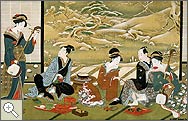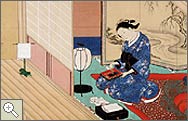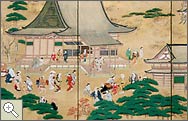
The screen is one of the most distinctive forms of Japanese art. Uniquely adaptable to a variety of settings, screens function both as freestanding partitions that define architectural space and as formats for the display of art. Many of Japan's greatest artists created paintings and calligraphy for folding screens known as byobu, which literally means "protection from wind".
Folding screens ideally suit the flexible spatial environment of traditional Japanese architecture, in which most interior partitions consist of sliding panels (fusuma) rather than fixed walls. Compact when closed, folding screens can be conveniently moved and extended fully to provide a stately, formal setting for a ceremony or official meeting or arranged to encompass a more intimate space for serving tea, reading, writing, or sleeping. In traditional Japanese rooms, such activities take place on the floor, which is covered by tatami mats. The change of a few furnishings can transform the function of the room.
Types of Screens
Single-panel screens known in Japanese as tsuitate often stand near entrances to buildings, in corridors, and in small spaces. Folding screens (byobu ), which range from two to ten panels, may be opened in various configurations to define smaller spaces within a room.
The most common format is the pair of six-panel screens, each screen measuring about one and a half meters high and about three and a half meters wide (approximately five feet high and about eleven and one-half feet wide). The design of a pair of screens may form a single composition when the screens stand side by side, but they usually have complementary themes, such as landscapes of the spring and autumn. When screens are intended for audience rooms or ceremonial display, the paintings usually depict auspicious subjects denoting dignity and power, such as pine trees or lions. Such screens are designed to be viewed from a distance. Low screens of two panels, each one-half meter (approximately one and two thirds feet) or more in height, are well suited to small tea gatherings or for embellishing a private living space. The intimacy of the space allows viewers to see art such as calligraphy, scattered fans, or a detailed painting at close range.
Construction of Japanese Screens
Like sliding fusuma panels, screens are made of a latticework of wood on which large sheets of paper are attached to from a taut, continuous surface. Painting and calligraphy for screens are usually executed on paper or occasionally on silk. Either material may be painted in subdued tones of ink or richly embellished with silver and gold. The whole screen is framed in wood, which may be lacquered and embellished with metal ornaments.
The nearly invisible system of paper hinges used to join the panels to form a folding screen was invented during the Kamakura period (1185 — 1333). This innovation enhanced the artistic potential of the Japanese screen by providing a visually continuous surface for large-scale paintings.
History of Screens in Japan
The first screens used in Japan, from the seventh to the eighth century, came from China and Korea. Later, screens were made in Japan.
Laborious and expensive to produce, screen paintings were often commissioned by patrons who expressed their artistic preferences through their choice of subjects and styles. Monochromatic ink painting, initially inspired by Chinese paintings, became an important style in Japanese screen painting beginning in the fourteenth century.
The large, continuous format of screens is especially suited to brilliant designs using color, often embellished with gold and silver. Gold leaf, which came into extensive use during the sixteenth century, covers the surface of some of the most magnificent screens. This translucent material softly reflects the muted light within traditional Japanese rooms, where the effect of the gold is more subtle than it appears in modern, artificial lighting.
The stability and prosperity of the Edo period (1615 — 1868) encouraged artistic innovation, stimulated by the emergence of new patrons from the merchant class.
Themes of Screen Painting
Landscapes of the four seasons or of spring and autumn have been popular themes in Japanese screen painting since the fourteenth century. Also common are narrative themes based on Chinese or Japanese literature. Calligraphy of Japanese or Chinese poetry appealed to the tastes of educated patrons. Tigers, dragons, popular deities, and even ghosts appear on screens. Beginning in the sixteenth century, screens depicted genre scenes of picnics and other activities in the cities and countryside.
An indispensable element of the daily environment of privileged Japanese households, Japanese screens, like many of the most highly esteemed Japanese arts, had both a practical and an aesthetic value. Among the most precious treasures of private and public art collections, screen paintings represent some of the most brilliant artistic achievements of Japan.
Adapted from an essay in A Closer Look: Japanese Screens by Ann Yonemura, Freer Gallery of Art.
|
 |
 |
 |
 |

Winter Party
By Utagawa Toyoharu
|
 |
 |

Ukiyo-e school, Edo period, eighteenth-ninenteenth century
Ink , color and gold on silk
Freer Gallery of Art
accession number 00.113
52.7 x 96.3 cm
(20 3/4 x 37 15/16")
1997 Freer Gallery of Art, Smithsonian Institution
|
 |
 |
 |
 |
 |
 |

Girl Preparing Ink
By Nishikawa Sukenobu
|
 |
 |

1671-1751
Edo period
Color, black and gold on silk
Freer Gallery of Art
accession number 99.19
35 x 65.7 cm
(13 13/16 "x 25 7/8")
1997 Freer Gallery of Art, Smithsonian Institution
|
 |
 |
 |
 |
 |
 |

Autumn at Asakusa Temple
By Hishikawa Moronobu
|
 |
 |

Ukiyo-e school, Edo period, seventeenth century
Ink , color and gold on silk
Freer Gallery of Art
accession number 06.266
165.6 x 367.9 cm
(65 3/16 x 12' 7/8")
1997 Freer Gallery of Art, Smithsonian Institution
|
 |
 |
 |
|

